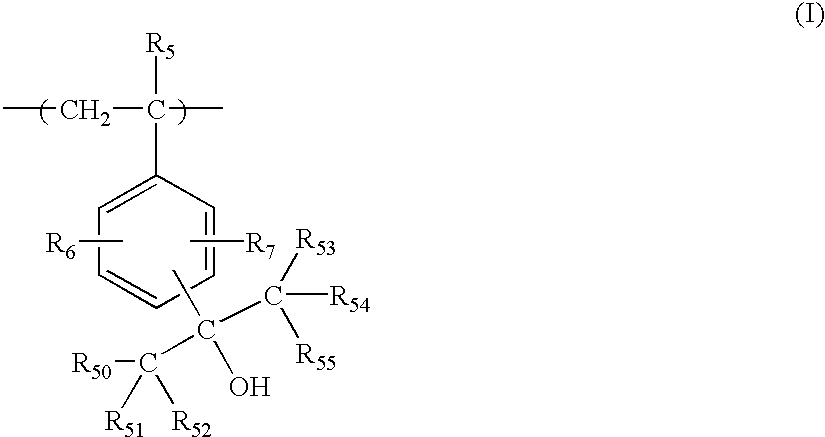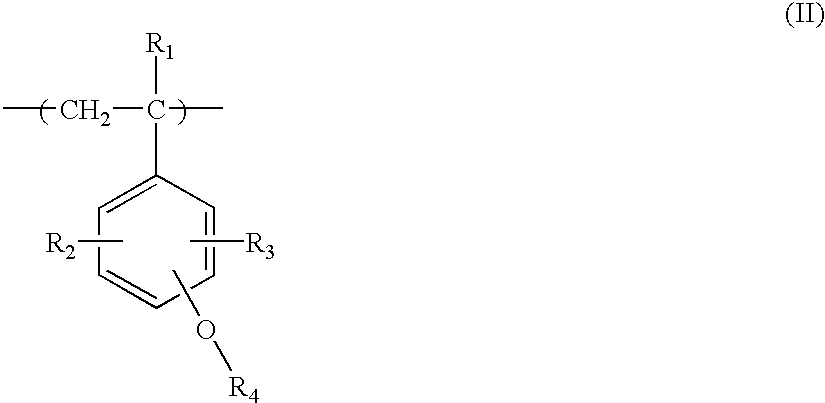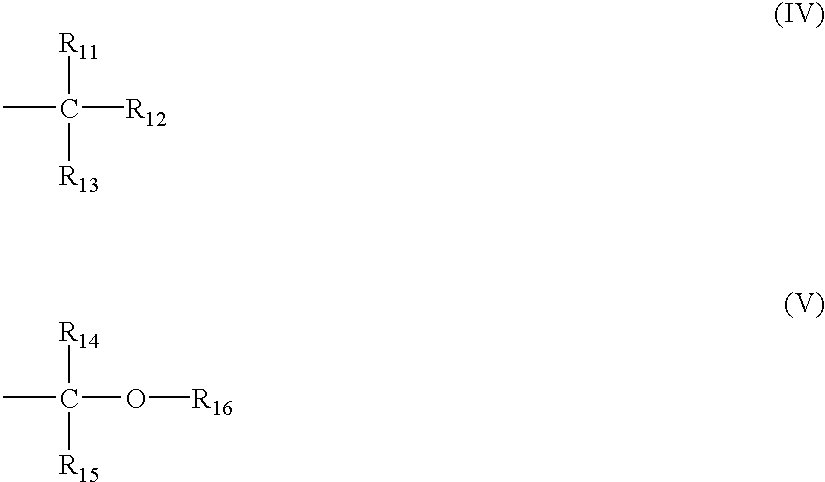Positive resist composition
a technology of resist and composition, applied in the direction of photosensitive materials, instruments, photomechanical equipment, etc., can solve the problems of low resist sensitivity, difficult to reach the bottom portion of the resist, and pattern having a tapered configuration, etc., and achieve satisfactory performan
- Summary
- Abstract
- Description
- Claims
- Application Information
AI Technical Summary
Benefits of technology
Problems solved by technology
Method used
Image
Examples
synthesis example 1
Into 60 ml of 1-methoxy-2-proanol were dissolved 18.9 g (0.07 mol) of 4-[bis(trifluoromethyl)-hydroxymethyl]styrene, 3.52 g (0.02 mol) of 4-t-butoxystyrene, 1.04 g (0.01 mol) of styrene. To the resulting solution, 0.25 g of 2,2′-azobis(2,4-dimethylvaleronitrile) (manufactured by Wako Pure Chemical Industries, Ltd. with a trade Name of V-65) was added as a polymerization initiator. This solution was added dropwise to 10 ml of 1-methoxy-2-propanol heated to 70° C. over the period of 2 hours under stirring along with the injection of nitrogen gas. After the completion of addition, stirring was continued for 4 hours. Thereafter, the reaction solution was thrown into 1 liter of a methanol / ion-exchanged water (1 / 1) mixture under vigorous stirring. The deposited resin was washed with ion-exchanged water, filtered and dried in vacuo to give 16.1 g of a white resin. By an NMR measurement, it was confirmed that this resin has the structure of P-1 (consisting of the repeating units listed in T...
synthesis example 2
Into 60 ml of 1-methoxy-2-propanol were dissolved 18.9 g (0.07 mol) of 4-[bis(trifluoromethyl)-hydroxymethyl]styrene, 3.52 g (0.02 mol) of 4-t-butoxystyrene, 1.94 g (0.01 mol) of pentafluorostyrene. To the resulting solution, 0.25 g of 2,2′-azobis(2,4-dimethylvaleronitrile) (V-65 manufactured by Wako Pure Chemical Industries, Ltd.) was added as a polymerization initiator. This solution was added dropwise to 10 ml of 1-methoxy-2-propanol heated to 70° C. over the period of 2 hours under stirring along with the injection of nitrogen gas. After the completion of addition, stirring was continued for 4 hours. Thereafter, the reaction solution was thrown into 1 liter of a methanol / ion-exchanged water (1 / 1) mixture under vigorous stirring. The deposited resin was washed with ion-exchanged water, filtered and dried in vacuo to give 16.1 g of a white resin. By NMR measurement, it was confirmed that this resin has the structure of P-21 (consisting of the repeating units listed in Table 1 in m...
synthesis example 3 (
Synthesis of Resin P-41)
Into 60 ml of 1-methoxy-2-propanol were dissolved 18.9 g (0.07 mol) of 4-[bis (trifluoromethyl)-hydroxymethyl]styrene, 3.52 g (0.02 mol) of 4-(t-butoxy)styrene, and 2.36 g (0.01 mol) of 1,1-bis(trifuloromethyl)-ethyl acrylate. To the solution 0.25 g of 2,2′-azobis(2,4-dimethylvaleronitrile) (V-65 manufactured by Wako Pure Chemical Industries, Ltd.) was added as a polymerization initiator. This solution was added dropwise to 10 ml of 1-methoxy-2-propanol heated to 70° C. over the period of 2 hours under stirring along with the injection of nitrogen gas. After the completion of addition, stirring was continued for 4 hours. Thereafter, the reaction solution was thrown into 1 liter of a methanol / ion-exchanged water (1 / 1) mixture under vigorous stirring. The deposited resin was washed with ion-exchanged water, filtered and dried in vacuo to give 15.6 g of a white resin. By NMR measurement, it was confirmed that this resin has the molar composition of 70 / 20 / 10. A G...
PUM
| Property | Measurement | Unit |
|---|---|---|
| Transmittivity | aaaaa | aaaaa |
| Transmittivity | aaaaa | aaaaa |
| Transmittivity | aaaaa | aaaaa |
Abstract
Description
Claims
Application Information
 Login to View More
Login to View More - R&D
- Intellectual Property
- Life Sciences
- Materials
- Tech Scout
- Unparalleled Data Quality
- Higher Quality Content
- 60% Fewer Hallucinations
Browse by: Latest US Patents, China's latest patents, Technical Efficacy Thesaurus, Application Domain, Technology Topic, Popular Technical Reports.
© 2025 PatSnap. All rights reserved.Legal|Privacy policy|Modern Slavery Act Transparency Statement|Sitemap|About US| Contact US: help@patsnap.com



